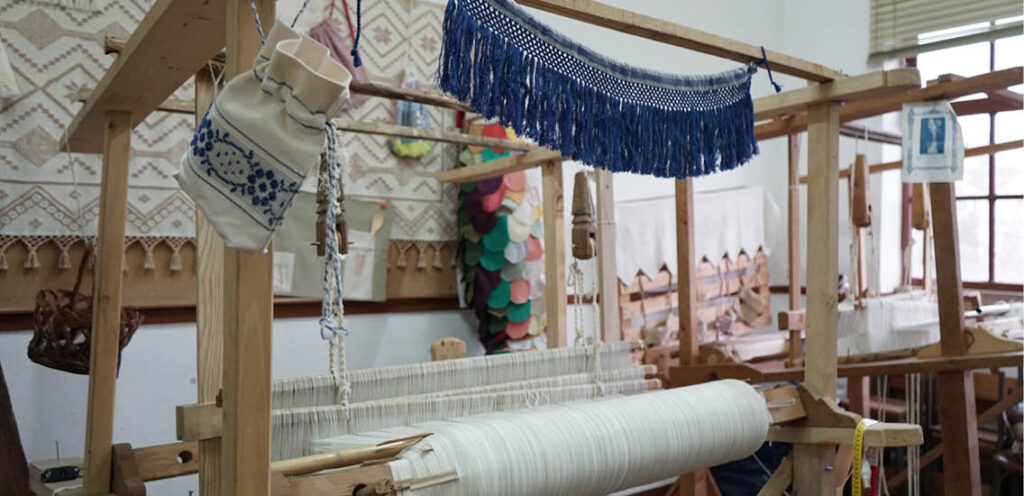Almalaguês handweaving is an 11th Century textile craft uniquely found to be in practice in the rural communities of Almalaguês and Anagueis located on the outskirts of Coimbra in Central Portugal.
Almalaguês handweaving is an 11th Century textile craft found to be in practice in two specific two rural communities, the villages of Almalaguês and Anagueis located on the outskirts of Coimbra in Central Portugal. This homespun craft is characterised by subtle warp and weft manipulations that allow the weave to be presented as a stratiform with jacquard-like reliefs of geometric motifs displaying over regular two-ply bases. The handloom on which the textile is woven is configured in a manner that lends robustness to the weave structure,
to such an extent that the eventuating products such as bedcovers and floor rugs have been known to last several generations of use and are routinely passed down as family heirlooms between generations. This aspect of the craft mirrors the intergenerational hand over of Almalaguês’s customs and traditions between the women of a household. Although geographically limited, the local prevalence of the craft and its inseparable relationship with the surrounding society and environment transitions the craft of Almalaguês from a vocation to an institution as a cultural
marker. The craft’s deep significance to the social and industrial history of the region, and to Portugal overall, is however marred by its relative obscurity, which is abetted by limited market ingress and a deficit of inscription in public and academic spheres. In this regard, project Anti-Amnesia has strived to legitimise the empirical and practice-led knowledge that is embedded in the rich manufacturing traditions of Almalaguês: in and through design education and research.
The handloom on which the textile is woven is configured in a manner that lends robustness to the weave structure, to such an extent that the eventuating products such as bedcovers and floor rugs have been known to last several generations of use and are routinely passed down as family heirlooms between generations.
The curricular premise of the project’s learning-based collaboration with Almalaguês handweaving has been to acknowledge its historical and semantic capital by means of reinterpreting its visual and material culture through contemporary design. The conducted modules have invited practitioners from both craft and design to engage in a productive dialogue towards fostering opportunities for interdisciplinary and intergenerational learning.

Almalaguês handweaving is an 11th Century textile craft uniquely found to be in practice in the rural communities of Almalaguês and Anagueis located on the outskirts of Coimbra in Central Portugal.
Almalaguês handweaving is an 11th Century textile craft found to be in practice in two specific two rural communities, the villages of Almalaguês and Anagueis located on the outskirts of Coimbra in Central Portugal. This homespun craft is characterised by subtle warp and weft manipulations that allow the weave to be presented as a stratiform with jacquard-like reliefs of geometric motifs displaying over regular two-ply bases. The handloom on which the textile is woven is configured in a manner that lends robustness to the weave structure, to such an extent that the eventuating products such as bedcovers and floor rugs have been known to last several generations of use and are routinely passed down as family heirlooms between generations. This aspect of the craft mirrors the intergenerational hand over of Almalaguês’s customs and traditions between the women of a household. Although geographically limited, the local prevalence of the craft and its inseparable relationship with the surrounding society and environment transitions the craft of Almalaguês from a vocation to an institution as a cultural marker. The craft’s deep significance to the social and industrial history of the region, and to Portugal overall, is however marred by its relative obscurity, which is abetted by limited market ingress and a deficit of inscription in public and academic spheres. In this regard, project Anti-Amnesia has strived to legitimise the empirical and practice-led knowledge that is embedded in the rich manufacturing traditions of Almalaguês: in and through design education and research.
The handloom on which the textile is woven is configured in a manner that lends robustness to the weave structure, to such an extent that the eventuating products such as bedcovers and floor rugs have been known to last several generations of use and are routinely passed down as family heirlooms between generations.
The curricular premise of the project’s learning-based collaboration with Almalaguês handweaving has been to acknowledge its historical and semantic capital by means of reinterpreting its visual and material culture through contemporary design. The conducted modules have invited practitioners from both craft and design to engage in a productive dialogue towards fostering opportunities for interdisciplinary and intergenerational learning.
The project “Anti-Amnésia: Investigação em Design como agente para a regeneração e reinvenção, narrativas e materiais, de culturas e técnicas de manufactura portuguesas em desaparecimento” (POCI-01-0145-FEDER-029022) is supported by Competitiveness and Internationalisation Operational Programme (POCI), under the PORTUGAL 2020 Partnership Agreement, through the European Regional Development Fund (ERDF) and through national funds by the FCT – Fundação para a Ciência e a Tecnologia.